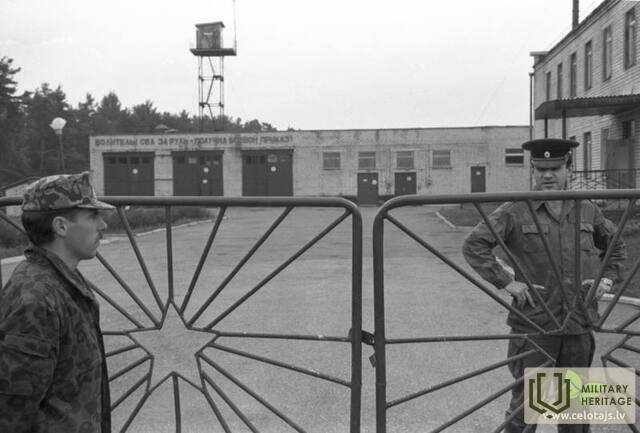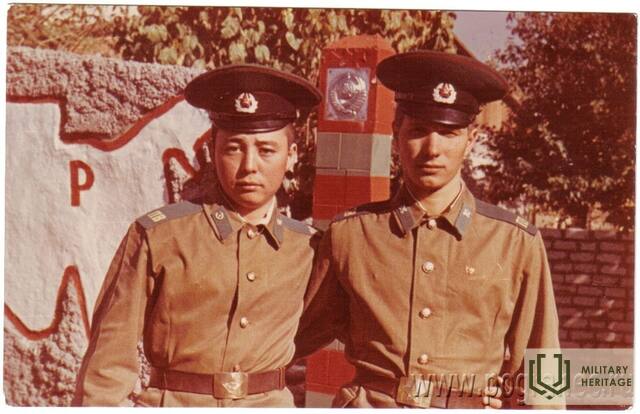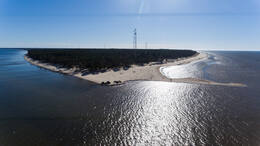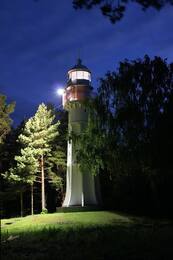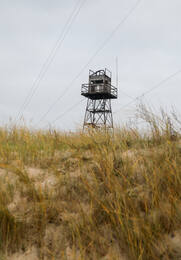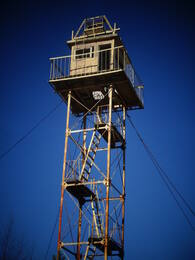About the Kolka Coast Border Guards
Kolka resident Valija Laukšteine's memories of the times in Kolka when there were border guards.
"I was born a collective farmer, my grandson will be the fifth generation. In 1954, I graduated from high school, entered the Kaliningrad University of Food Technology, but it was all in Russian, I stopped studying because I got married and didn't want to study any further. I started working in the laboratory of the Fish Processing Factory, then I moved to the artel "Free Fisherman", then the fishermen's collective farm, and worked until retirement, until 1991. I lived in the house "Sārnati" built by the collective farm (1962), then bought and paid for by my father, there was also an old house here before, one of the first old farms in Kolka.
During the war, we had left, evacuated up near Dundaga in Āži, where my mother's father's brother lived. My father also got a pass from the Germans during the war, because he was a fisherman and went fishing. We came back to Kolka before 1945, because the war was not over yet. Not all families were evacuated.
When the border guards first came in, well... I was already little, it was right after the war, I was 10-11 years old. There was already a big difference, because before that, Germans had already lived here and then Russians. The Germans were gallant. The Russians came in, right after the war, the view was different for them than for the victors. Privates had to be given rooms to settle in, because they had nowhere to live until they built barracks. Two women, Galina and Polina, both had boats at the head of them, lived with us. And then the routine started for us, all the boats were gathered together on the bay side, a fence in a circle, each boat was chained to a post, a key, a number. There was a border guard post at the top, then the fishermen had to go check in, get a permit, go to sea, then back. My father was the chairman of the collective farm at first, then the foreman, we were fishermen. Everyone couldn't go to the beach as they wanted, only to the places where they were allowed.
The border guards also came to check our homes, the old house book has records of the dates and times when the checks were carried out. They checked whether there were any strangers in the house. My older brother was taken to serve in the German army, after the war he lives in Canada. Therefore, we were considered an unfavourable family. One evening an old man came to our house, he was probably sent, spoke Latvian and asked for a place to stay, but strangers were not allowed to stay, strangers had to be reported immediately to the zastav (post). I don’t remember that we reported this to the zastav, but the border guards were there and took him into custody. The next morning the chief of the border guards thanked my father: “Thank you, Aleksandr!”, so we became more trustworthy. They had a headquarters in Ventspils, from where they managed the affairs and sent out the checks.
Our elementary school was next to the outpost. Girls are girls and they are also young boys, we often play ball together. Our teacher was Bernsteins, then it was already 1949 and the deportations, they already took everyone with the border guards and took them away to the outpost. But we are so young and continue to meet and talk to the border guards. The teacher was very angry with us, said "they are collecting men from Kolka, but you are just giggling here".
In later times, the chief of the border guards always participated in the regular parades held on February 23 in honor of the Day of the Soviet Army.
The border guards were of different nationalities, one was a Tatar, then Lithuanians, Russians, Belarusians, from all over the Soviet Union. I don't remember any Latvians. We communicated in Russian. Many border guards also married Latvians. There was a beautiful girl named Kristiņa, she married the chief Beļavinas, she stayed to live here, now in Riga. But several of them got married, other girls already left with the guys.
There were two churches in Kolka at the time, Lutheran and Orthodox, but at that time you weren't allowed to go, because people from school and workplaces were watching you. Most of the young people were already in the Pioneers, Komsomol, and then the party, and that wasn't allowed at all. There were those who went quietly, but then they got reprimands.
When there were celebrations in the village, the border guards came to the balls. The balls were held in the cultural center, but there was also dancing upstairs in the factory. Those who had received permission came to the parties, but they already had their own regime, they had to be at home at certain hours. The regime was more relaxed for the sailors who were in the cape. Both the sailors and the border guards participated in the sports festival.
There was a headquarters in Ventspils, then border guards would travel from Ventspils to Kolka to give concerts, and local residents would also come to listen. Then there were parties. My boss also fell in love with one of the Ventspils girls, and the two corresponded for a long time.
Many families from Lielirbe moved to Kolka, probably because the missile base was being built there.
There were two swimming areas in Kolka where locals were allowed to swim, opposite the culture house and further down. You weren't allowed to walk along the seashore all the time, so you had to get a permit from the border guard and tell them where you were going. When you go somewhere, there's always a check-up, you always have to have your passport with you, you can't take a step without it. If someone came to visit us, you had to go and register at the border guard's office, even though you had a permit. It's also happened that we go to Mazirbe ourselves and there's a border guard's check in Saunag. If someone doesn't have a passport with them, they take you up to the post and wait until they call and find out if that person lives in Kolka, then you can go further. The control was strict, you had to report everything, otherwise you look unfavourable. There were already spies in the village who were watching everything, there were a lot of them, I don't know if they were paid. My husband was a driver, taking workers to work in the Atlantic, and he always drove up to one of the border guards, who often made no secret of it and said, "We have someone in this house who gives us information." The area was covered in stucco.
The border guards also had dogs. Jurmala was cordoned off and every morning the border guards went to check with their dogs, the dogs looked for tracks, from time to time there were viškas (towers), the guards were on duty in them, they changed at certain times. Before Vaide, the Green Tower was called in. There was a point in Melnsila, a large point in Roja, because that's where the big ships went to sea. There were outposts in Melnsila, Kolka, Saunag, I don't know further.
Residents were not allowed inside the outpost. There was a guard at the gate, there was a pass, a large fence in a circle, if you needed anything, you called the boss outside. Well, if you were caught, you were taken inside to the boss, but that's another story. The outpost was for some time located in a manor building near the church and there was a school next to it, the windows that faced the outpost were bricked up, we were not allowed to see what was going on there, it was a war secret.
At first, officers and their families lived with privates. An officer's family lived right next door to us, his wife was a doctor, and he was the commander of the outpost. Later, a new outpost with barracks and an officers' house was built, and then the officers' families moved there. The barracks have not survived to this day."
<iframe width="640" height="480" src="https://latviainside.com/explore/tours/aero/kurzeme/360/virtualtour.html?fbclid=IwAR0eKPnc-9Q5dytnf6Kr0Est6RS0ClHpsH1rhbOPjU8O2YKjfCSh0AQgGz8" frameborder="0" allowfullscreen></iframe>
Related timeline
Related objects
German army coastguard searchlight site in Usi and border guard post in Kolka
No military infrastructure was planned in Cape Kolka, except for several offshore lighthouses that were rebuilt over a long period of time, either before World War I, during World War I or during World War II. Coastal defence batteries were planned for the narrowest part of the Irbe Strait, between the Sirves Peninsula and the Michael Tower Lighthouse.
The only fortifications of a military nature appeared at the end of 1944, when the German Army Group North was preparing to repel possible landings by the Soviet Baltic Fleet. In the spring of 1945, after the ice retreated, two batteries of the 532nd Artillery Division defended the coast at Cape Kolka. Battery 7 with four 75 mm guns and three 20 mm zenith guns. Battery 8 with four 88 mm mortars, three 20 mm mortars and an 81 mm mortar. The anti-deserter infantry garrison consisted of one of the most famous coastal defence units of the German Navy, the 5th Company of the 531st Artillery Division. Although it was an artillery unit by name, it was an infantry unit by deployment, which started its war in June 1941 at Liepāja. The unit was then garrisoned on islands in the Gulf of Finland and later took part in the fighting on the island of Saaremaa. The remnants of the division were reformed into one company and, reinforced with seven anti-tank guns and three 20 mm anti-aircraft guns, deployed at Cape Kolka.
The Soviet naval landing operation never took place and the German units capitulated in May 1945.
The military infrastructure in Cape Kolka began to be built after the Second World War, when Soviet border guard posts were deployed here and Kolka, like the entire Kurzeme coast from Mērsrags to the Lithuanian border, became a closed zone
Mērsrags lighthouse and former border guard
Mērsrags Lighthouse is located in the Mērsrags village, about 1 km north of the village centre. The lighthouse was put into commission in 1875. It is an 18.5 m tall freestanding, cylindrical, riveted iron tower, the lower part of which has been fortified with reinforced concrete counterforts. The height of the signal light is 21.3 m. At the top all around the tower there is an iron balcony supported by consoles. The lighthouse tower was made by Sotera, Lemonier & Co in Paris, so this lighthouse is commonly known as the ‘Frenchie’. At the end of 1944, the 1003rd Artillery Division Battery of the German Army with 60 cm spotlights was located right next to the lighthouse. In May 1945, the Nazi Germany high command planned to move the 15th Latvian SS Grenadier Division to the area, but these plans failed, because Latvian soldiers surrendered to the Western Allies. Near the Mērsrags Lighthouse there are still remains of a building where during the USSR times Soviet border guards had a large, extendable spotlight for illuminating the sea. There is a bird-watching tower next to the lighthouse. Tours need to be booked beforehand by contacting the Mērsrags Tourism Information Centre.
Soviet border guard post in Jūrmalciems
After the Second World War, Latvia had various prohibitions in border and coastal areas. From 19 June 1945, fishermen were assigned piers, which were fenced off with barbed wire, guarded by patrols and watchtowers. On 4 September 1946, the prohibited coast guard zones on the Western border of the LSSR were introduced.
In Jūrmalci village there is a former border guard control post, a tower and a tractor proudly rocking on the beach! How it got there is something to ask the local guides!
A fabulously beautiful and interesting place - both with its Soviet-era aura and the charm of the seashore.
Mazirbe border guard tower
The Soviet border defence post was located in the building that used to be a maritime school, and next to it is a well-preserved Soviet border guard watchtower. The second watchtower is located right on the shore next to a parking lot. These watchtowers are a reminder of the Soviet occupation and the times when Mazirbe was a closed border area and civilians were allowed on the shore only in specially designated places and only during the daytime. This border guard watchtower is one of the best-preserved objects of its type on the coast of Latvia. However, it designated is dangerous to climb it.
Mazirbe boat cemetery
Mazirbe, historically known as the largest Liv centre, is notable for the only fishermen's boat cemetery on the Latvian coast. It was built in the 1960s, the last boats were brought in 1976. The boats ended up here as a result of both fishing restrictions and age.
Today, Mazirbe has less than ten wrecks of fishing boats, but historically there have been many more. Boats have been laid to rest in other seaside villages, but it is in Mazirbe's boat graveyard that this is most evident today.
The Mazirbe Boat Cemetery is the only one of its kind on the Latvian coast.




